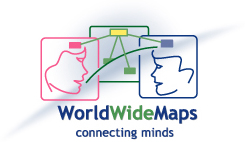More informations about WorldWideMaps Project
WWMAPS project allows children from different countries world-wide to construct concept maps collaboratively although being far away from each other. This is an amusing and interactive way to develop learning and construct new concepts, starting from experiences and prior knowledge of the children.
Concept maps (Cmaps) offer a synthetic and accurate way to construct meaningful propositions and to follow the development of the new knowledge at the same time that these are being constructed. Cmaps technology is the least demanding tool to make the children skilled at working collaboratively. Diversity of language wouldn’t pose a serious problem, if we are careful in creating multilingual CMaps, as the ones in our project.
Cmaps are formed by basic propositions (subject - predicate - object) whose structure remains unaffected through translation.
On the other hand, Cmaps have the minimum number of concepts and labels, the latter staying together in the nodes of such multilingual maps. These are the reasons why a faithful translation of a conceptual map is easier than translating a common text with the same meanings and contents. Thanks to technology, a Cmap can be constructed as a shared area among distant students, where they can introduce resources (images, texts, audio-visual, Web pages, etc.), talking about own life experiences, culture or content subjects. The CMaps allow most communication and interactions with the least words, that can also help to learn a new language.
From the page "participate to the project" you can download packages of instructions with the least necessary information, useful to those who are completely unfamiliar about concept mapping, and a document with more detailed suggestions on the possible approaches towards collaboration.
